Israeli tanks take control of Gaza side of Rafah crossing
By Sam Mednick, Josef Federman and Bassem Mroue
Jerusalem: An Israeli tank brigade has seized control of the Gaza Strip side of the Rafah border crossing with Egypt, authorities said, proceeding with an offensive in the southern city even as ceasefire negotiations with Hamas remain on a knife’s edge.
The Israeli 401st Brigade entered the Rafah crossing on Tuesday afternoon (AEST), the Israeli military said, taking “operational control” of the crucial crossing. It’s the main route for aid entering the besieged enclave and exit for those able to flee into Egypt. Israel fully controls all access in and out of Gaza since the war began.
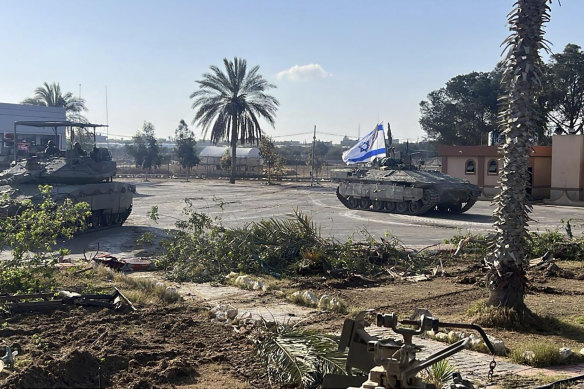
A tank with an Israel flag on it entering the Gaza side of the Rafah border crossing on Tuesday.Credit: IDF/AP
Footage released by the Israeli military showed a tank entering the crossing. Details of the video matched known features of the crossing and showed Israeli flags flying from tanks that seized the area.
The Israeli military claimed it seized the crossing after receiving intelligence it was “being used for terrorist purposes”. The military did not provide evidence to immediately support the assertion, though it alleged the area around the crossing had been used to launch a mortar attack that killed four Israeli troops and wounded others near the Kerem Shalom Crossing.
The Gaza Crossings Authority said in a statement that Israel’s takeover was a “death sentence” against Gazans, particularly the ill and injured.
It’s the first time Israel’s army has entered the crossing since the Gaza war started in October. Throughout the seven-month war, Rafah, the only crossing not run by Israel, has been the main lifeline to the outside world for Gaza’s 2.3 million Palestinians, allowing humanitarian supplies in and transport of patients out during severe shortages and destruction of healthcare facilities.
The Israeli military also said that ground troops and airstrikes targeted suspected Hamas positions in Rafah.
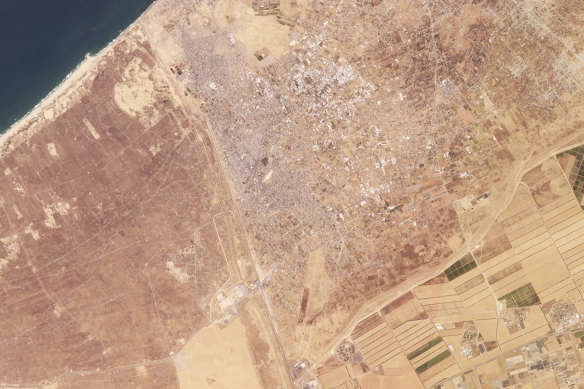
The city of Rafah in southern Gaza Strip on Saturday. Israeli farms can be seen across the border (bottom right).Credit: Planet Labs/AP
Wael Abu Omar, a spokesman for the Palestinian Crossings Authority, acknowledged Israeli forces had seized the crossing and had closed the facility for the time being. He said strikes had targeted the area around the crossing since Monday.
“The whole western area [of Rafah] has become a theatre of operations since yesterday. The bombardment has not stopped,” said Abu Omar, adding that crews have fled the facilities because of the bombing.
The Israeli army has “stopped the movement of people and aid completely,” the Hamas-run crossing authority said in a statement.
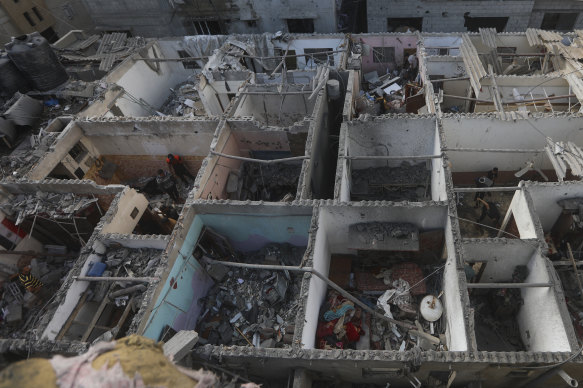
Palestinians look at the destruction after an Israeli strike on residential building in Rafah, Gaza Strip, on Tuesday.Credit: AP
The Israeli army said 20 Hamas militants were killed in the Monday operation and it discovered three tunnel shafts. Israeli airstrikes also hit elsewhere in Rafah on Tuesday, killing at least five people, including a child and a woman, hospital officials said.
The movement of troops to the area came a day after Israel told residents in parts of eastern Rafah to leave immediately ahead of a possible attack on the city. An Israeli army official said the vast majority of people located in an ordered evacuation zone had left.
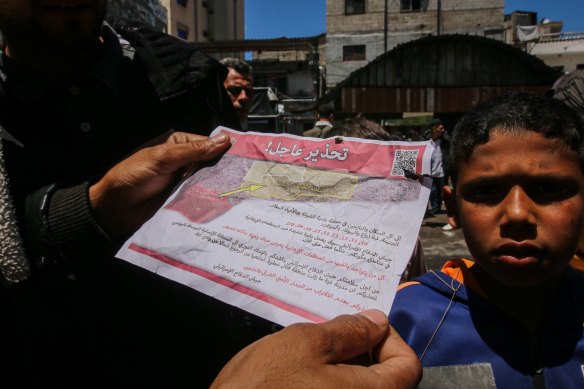
Palestinians read leaflets dropped by Israeli aircraft warning them to evacuate on Monday ahead of military operations in Rafah, Gaza.Credit: Bloomberg
An Egyptian Foreign Ministry spokesperson declined to immediately comment on the Israeli border seizure. Egypt previously has warned any seizure of Rafah could see Palestinians fleeing over the border, a scenario that could threaten a 1979 peace deal with Israel that’s been a linchpin for regional security.
The offensive again raised the risks of an all-out Israeli assault on Rafah, a move the United States strongly opposes and that aid groups warn will be disastrous for some 1.4 million Palestinians taking refuge there.
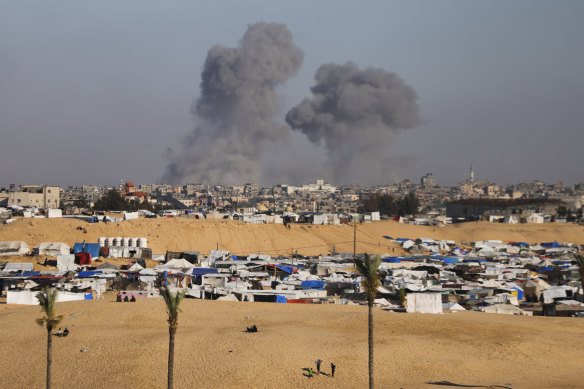
Smoke rises following an Israeli airstrike in Rafah’s east.Credit: AP
Ceasefire talks between the two sides continue to drag. Hamas said earlier it had accepted a proposal from mediators Egypt and Qatar. Israel rejected it, saying it contained demands the Jewish state could not accept – it said it did not meet its “core demands”. It said was pushing ahead with an assault on Rafah.
Egyptian officials said the proposal called for a ceasefire of multiple stages starting with a limited hostage release and partial Israeli troop pullbacks within Gaza. The two sides would also negotiate a “permanent calm” that would lead to a full hostage release and greater Israeli withdrawal out of the territory, they said.
Hamas sought clearer guarantees for its key demand of an end to the war and complete Israeli withdrawal in return for the release of all hostages, but it wasn’t clear if any changes were made.
Israeli leaders have repeatedly rejected that trade-off, vowing to keep up their campaign until Hamas is destroyed after its October 7 attack on Israel that triggered the war.
Israel’s War Cabinet decided to continue the Rafah operation, Prime Minister Benjamin Netanyahu’s office said on Monday.
US President Joe Biden spoke with Netanyahu and reiterated American concerns about an invasion of Rafah. US State Department spokesman Matthew Miller said American officials were reviewing the Hamas response “and discussing it with our partners in the region”. An American official said the US was examining whether what Hamas agreed to was the version signed off to by Israel and international negotiators or something else.
It was not immediately known if the proposal Hamas agreed to was substantially different from one that US Secretary of State Antony Blinken pressed the militant group to accept last week, which Blinken said included significant Israeli concessions.
Ceasefire deal agreed to by Hamas
PHASE ONE
- Ceasefire lasting 42 days
- Hamas releases 33 Israeli hostages in return for Israel releasing Palestinians from Israeli jails
- Israel partially withdraws troops from Gaza and allows free movement of Palestinians from south to north Gaza
PHASE TWO
- Another 42-day period that features an agreement to restore a “sustainable calm” to Gaza, language that an official briefed on the talks said Hamas and Israel had agreed in order to take discussion of a “permanent ceasefire” off the table
- The complete withdrawal of most Israeli troops from Gaza
- Hamas releases Israeli reservists and some soldiers in return for Israel releasing Palestinians from jail
PHASE THREE
- The completion of exchanging bodies and starting the implementation of reconstruction according to the plan overseen by Qatar, Egypt and the United Nations
- Ending the complete blockade on the Gaza Strip
Egyptian officials said that proposal called for a ceasefire of multiple stages starting with a limited hostage release and partial Israeli troop pullbacks within Gaza. The two sides would also negotiate a “permanent calm” that would lead to a full hostage release and greater Israeli withdrawal out of the territory, they said.
Hamas sought clearer guarantees for its key demand of an end to the war and complete Israeli withdrawal in return for the release of all hostages, but it wasn’t clear if any changes were made.
Israeli leaders have repeatedly rejected that trade-off, vowing to keep up their campaign until Hamas is destroyed after its October 7 attack on Israel that killed about 1200 people and triggered the war.
Netanyahu is under pressure from hard-line partners in his coalition who demand an attack on Rafah and could collapse his government if he signs onto a deal. But he also faces pressure from the families of hostages to reach a deal for their release.
Thousands of Israelis rallied around the country calling for an immediate agreement. About a thousand protesters swelled near the defence headquarters in Tel Aviv, where police tried to clear the road. In Jerusalem, about a hundred protesters marched toward Netanyahu’s residence with a banner reading, “The blood is on your hands”.
Israel says Rafah is the last significant Hamas stronghold in Gaza, and Netanyahu said that the offensive against the town was vital to ensuring the militants can’t rebuild their military capabilities.
The looming operation has raised global alarm. Aid agencies have warned that an offensive will bring a surge of more civilian deaths in an Israeli campaign that has already killed 34,000 people and devastated the territory. It could also wreck the humanitarian aid operation based out of Rafah that is keeping Palestinians across the Gaza Strip alive, they say.
UN High Commissioner for Human Rights Volker Türk called the evacuation order inhumane.
“Gazans continue to be hit with bombs, disease, and even famine. And today, they have been told that they must relocate yet again,” he said. “It will only expose them to more danger and misery.”
Israeli leaflets, text messages and radio broadcasts ordered Palestinians to evacuate eastern neighbourhoods of Rafah, warning that an attack was imminent and anyone who stays “puts themselves and their family members in danger”.
The military told people to move to an Israel-declared humanitarian zone called al-Mawasi, a makeshift camp on the coast. It said Israel has expanded the size of the zone and that it included tents, food, water and field hospitals.
About 450,000 displaced Palestinians are already sheltering in al-Mawasi.
The UN agency for Palestinian refugees, known as UNRWA, said it has been providing them with aid. But conditions are squalid, with few sanitation facilities in the largely rural area, forcing families to dig private latrines.
AP, Reuters, Bloomberg
Get a note directly from our foreign correspondents on what’s making headlines around the world. Sign up for the weekly What in the World newsletter here.